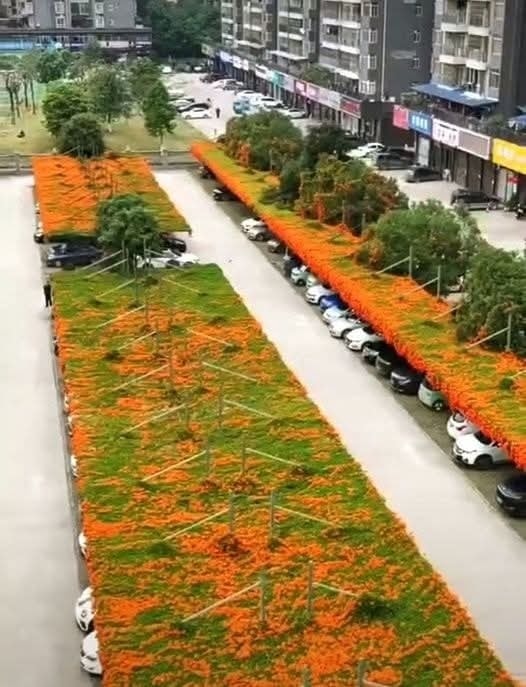
Floating Gardens on Parking Lot Roofs: Japan’s Green Revolution

As urbanization continues to reshape cities across the globe, innovative approaches are emerging to reintroduce nature into our increasingly concrete-dominated landscapes. Japan, a country known for its harmony between tradition and innovation, has taken a bold step toward urban sustainability by installing floating gardens on the rooftops of public parking structures. These elevated green spaces are not only visually captivating but also serve as vital habitats for pollinators such as bees and butterflies—creatures that play an essential role in preserving biodiversity.
A Forward-Thinking Green Initiative
The relentless expansion of urban environments has often come at the expense of natural ecosystems. The reduction of green areas contributes to worsening air quality, increased heat retention, and the displacement of wildlife. To counteract these effects, Japan has introduced floating gardens—lush green zones placed atop parking lots and other overlooked structures.
These rooftop gardens serve as a creative solution to maximize space usage in crowded urban areas, while helping to combat the adverse environmental impacts of concrete, steel, and asphalt. More than just a landscaping trend, this initiative represents a shift in how urban design can blend functionality with sustainability.
Key Benefits of Floating Gardens
1. Improving Air Quality
One of the most immediate benefits of incorporating greenery into urban areas is improved air quality. Plants naturally absorb carbon dioxide and release oxygen, but they also trap fine particulate matter and airborne pollutants. This contributes to cleaner, fresher air for residents—especially important in cities with dense traffic and industrial activity.
2. Creating Habitats for Pollinators
Urban development has drastically reduced habitats for essential pollinators. Floating gardens provide a sanctuary for bees, butterflies, and other insects, encouraging pollination and supporting local ecosystems. These small havens of biodiversity can have ripple effects on surrounding flora and urban agriculture initiatives.
3. Reducing the Urban Heat Island Effect
Concrete and asphalt absorb and retain heat, leading to higher temperatures in cities—a phenomenon known as the urban heat island effect. Green rooftops help offset this by providing natural insulation and reflecting sunlight. The plants also release moisture through transpiration, helping to cool the surrounding environment.
4. Enhancing Mental Well-Being and Urban Aesthetics
Green spaces are proven to reduce stress, improve mood, and increase overall well-being. By transforming dull, utilitarian structures like parking garages into vibrant gardens, cities can create more inviting and therapeutic spaces. These areas become not just functional but also places where people can relax, recharge, or reconnect with nature—even in the heart of the city.
5. Efficient Use of Underutilized Space
Urban space is at a premium. Floating gardens turn previously overlooked rooftops into productive, eco-friendly zones. They demonstrate how thoughtful design can optimize every square meter for the benefit of both people and the environment.
Implementation in Japan and Beyond
Japanese cities—especially Tokyo and Osaka—have embraced this green infrastructure movement with enthusiasm. Local governments and private developers alike are investing in the installation and maintenance of rooftop gardens on parking facilities, office buildings, schools, and shopping centers. Some initiatives have even incorporated community gardens, inviting citizens to take part in urban farming and stewardship of green spaces.
The success of these gardens in Japan is inspiring interest from urban planners and environmental advocates around the world. With climate change accelerating, integrating nature into built environments is no longer optional—it’s essential. Floating gardens offer a scalable, adaptable model that can be tailored to the unique needs and architecture of different cities.
A Blueprint for Greener Cities
Japan’s floating gardens offer more than just aesthetic improvements—they present a compelling vision for the future of urban life. By reimagining existing infrastructure through a sustainability lens, cities can unlock new possibilities for ecological balance, community engagement, and climate resilience.
As more urban centers face the twin challenges of population growth and environmental degradation, initiatives like rooftop gardens highlight the importance of reconciling development with nature. Whether it’s cooling city blocks, supporting pollinators, or improving residents’ mental health, these green spaces prove that even small changes in urban design can lead to big impacts.
Looking Ahead
Floating gardens are not merely a trend—they are a statement of intent. They symbolize a broader cultural shift toward environmental responsibility, innovation, and sustainable urban living. As other nations take note and adapt these ideas to their own contexts, a greener, healthier, and more harmonious urban future becomes not just possible, but achievable.
News in the same category


Humanity Has Officially Found 6,000 Exoplanets, NASA Announces

There’s A 90% Chance of Black Hole Explosion in the Next Decade, Scientists Say

Prime views of the Andromeda Galaxy and Ceres—October 2

Northern Lights Could Be Seen in Northern U.S. — Sept 30 – Oct 1, 2025

Alnitak, Alnilam, and Mintaka: Orion’s Belt Stars Thousands of Light-Years Away

Humanity Preserved: A 5D Crystal Holds 360 TB of Our Genome to Outlast Civilization

Researchers make groundbreaking discovery about ChatGPT after testing it with 2,400 year-old math problem

Why this city has introduced a screen time limit of 2 hours per day

The Truth Behind the Bermuda Triangle May Be Scarier Than UFOs

Over 99% of peer-reviewed studies confirm climate change is real and driven by humans

Passenger lands in hospital after humiliating TSA spat over stubborn jewelry

A Man Knocked Down His Basement Wall, Discovering Ancient Underground City That Housed 20,000 People

Magnificent 2300-Year-Old Scythian Woman’s Boot: A Timeless Fashion Statement

Mind-Blowing Cloud Formations You Probably Haven’t Seen Before

On the southern edge of the world, a waterfall runs red as blood

Rare reddish-orange snowy owl in Huron County captivates birdwatchers

Wildlife Crossings: A Vital Solution for Highway Safety and Biodiversity Conservation

Photographs reveal first glimpse of uncontacted Amazon community
News Post

Aloe Vera and Cinnamon Remedy: Natural Benefits for Eye Health, Immunity, and Healing

12 Powerful Benefits of Moringa Seeds

Goldenberries (Physalis peruviana): A Nutrient-Packed Powerhouse for Health and Vision

Oregano: The Golden Herb for Eye Health

Some of the Benefits of Castor Leaves and the Seed

10 Benefits and uses of purslane

Chanca Piedra (Stonebreaker): Benefits and Uses

Do you need to unplug the rice cooker after the rice is cooked: The surprising answer November 27, 2024

7 Benefits Of Papaya Seeds & How To Consume Them Correctly

Bougainvillea likes to 'eat' this the most, bury it at the base once and the flowers will bloom all over the branches

The elders say: "If you put these 3 things on top of the refrigerator, no matter how much wealth you have, it will all be gone." What are these 3 things?

Can rice left in a rice cooker overnight be eaten? Many people are surprised to know the answer.

After boiling the chicken, do not take it out immediately onto a plate. Do one more thing to make sure the chicken is crispy, the meat is firm, and the skin does not fall apart when cut.

Cut this fruit into small pieces and put it in the pot to boil the duck: The bad smell is gone, the meat is fragrant, soft and flavorful.

Warts on Hands: Causes and Effective Natural Treatments

Medicinal Health Benefits of Turmeric, Curcumin and Turmeric Tea Based on Science

4 ways to preserve green onions for a whole month without spoiling, fresh as new

The best way to lower blood pressure fast!

9 Habits You Need To Adopt Today To Stop Alzheimer’s or Dementia Before It Starts
